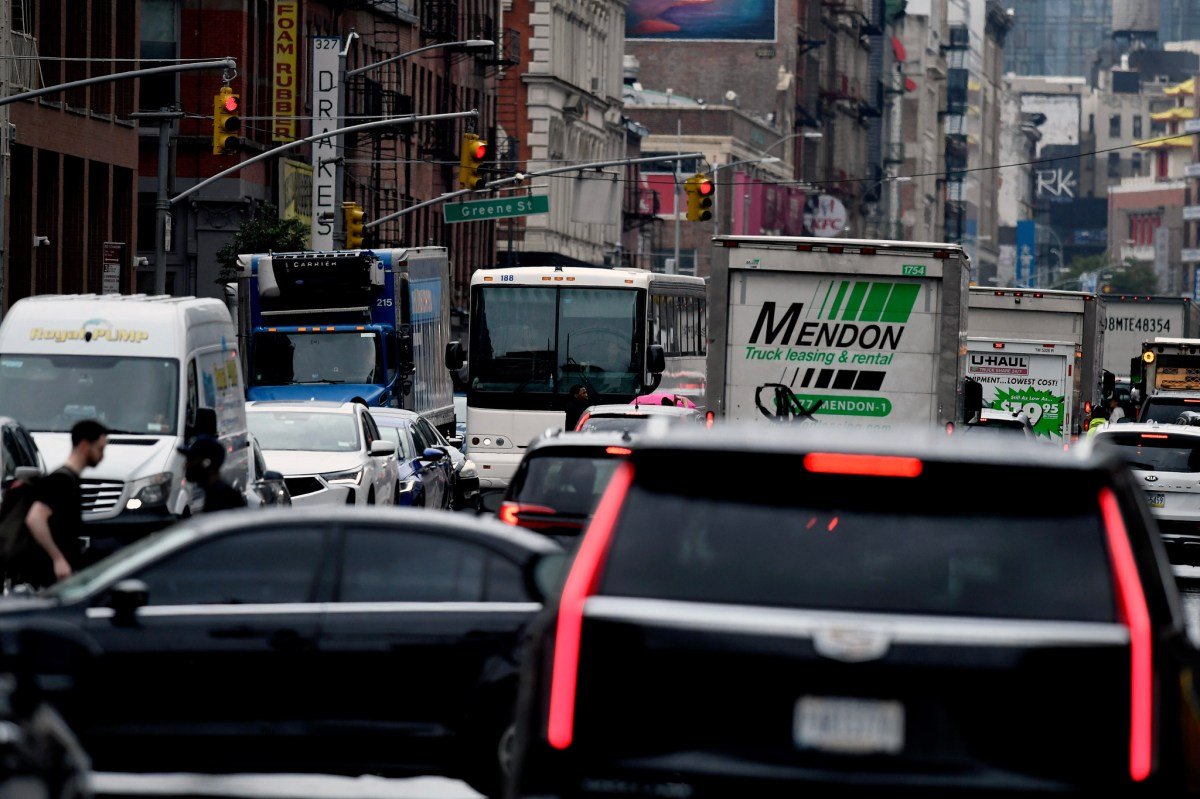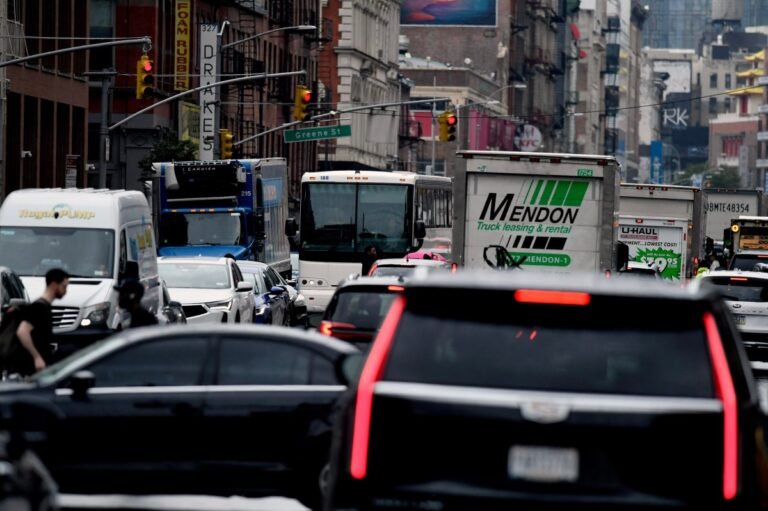
Traffic congestion in Manhattan in June 2023.
Marc A. Hermann / MTA
A new report finds that various proposals to replace the mass transit money lost from pausing congestion pricing either don’t raise the same revenue or fail to achieve other benefits—such as reduced traffic—from the Manhattan toll.
The report by the Permanent Citizens Advisory Committee to the MTA (PCAC), the transit authority’s in-house rider advocacy group, examined eight proposals that have been floated from various parties to replace the $15 billion congestion pricing was to generate for the MTA’s capital program, which is now on ice following Gov. Kathy Hochul’s decision in June to “pause” the Manhattan tolling scheme.
Congestion pricing, which would have charged $15 to most motorists entering Manhattan south of 60th Street, was expected to generate about $1 billion in revenue per year for the MTA, which could then be borrowed against in the bond market to raise $15 billion for mass transit modernization projects, like extending the Second Avenue Subway, replacing century-old signals that frequently break down and cause delays, and making more stations accessible for people with disabilities.
But only some of the proposed alternatives would raise the same amount of money, and even fewer would be bondable, the PCAC found. What’s more, none of the eight alternatives would lead to other benefits officials anticipated from congestion pricing, including improved air quality and reduced traffic in Manhattan’s central business district and surrounding environs.
“While imaginative, the proposed funding alternatives to close the hole created by the pause either fail to deliver the needed funding or cost working New Yorkers more, while missing out on the improvements to traffic and air quality,” said Lisa Daglian, executive director of the PCAC. “Some will be better suited for future funding streams. We already have one for the current plan: Congestion Pricing.”
Those that could feasibly raise the necessary annual revenue include raising taxes on the ultra-wealthy, increasing payroll taxes on city businesses, and a $1 billion “IOU” committed by the governor annually from the state budget to MTA capital funds, the latter two having been floated by Hochul to legislators following the pause but quickly being rejected. There’s also increasing sales taxes and redirecting tax revenues from forthcoming downstate casinos to the MTA capital plan.
But all of these come with their own challenges. Increasing payroll taxes or sales taxes would likely lead to increased consumer prices, a potential nonstarter for the governor considering her stated rationale to pause the toll is to not slap working-class New Yorkers with an additional cost. Hochul has also steadfastly refused to consider raising taxes on the wealthy during her three years as governor and is not likely to reconsider any time soon.
A $1 billion annual commitment from the general fund, meanwhile, is only worth the governor’s word, and would be both subject to funding raids and not bondable, per the PCAC. Meanwhile, the MTA’s operating budget — which covers everyday expenses like payroll and electricity to run trains — is already set to be substantially supported by casino revenue, and redirecting that money to fund capital needs would effectively defund daily operations.
Other proposals would be even less helpful, per the PCAC. Some legislators opposed to congestion pricing have proposed the MTA instead combat the rampant fare evasion problem that costs the authority some $700-800 million per year in foregone revenue, but the watchdog finds several issues with the call.
For one, even if every dollar was recovered, it wouldn’t be as much as the MTA is statutorily required to collect through congestion pricing. And were all those people hopping turnstiles to pay their fare instead, the money would go towards the operating budget. Combatting fare evasion costs money, including with the unarmed turnstile guards on the subway, fare inspectors on the bus, and thousands of additional cops now patrolling the transit system, so efforts to combat it cannot recover the full dollar amount.
The MTA also intends to redesign its fare gates soon to make them harder to jump, but doing so requires a substantial capital investment that likely would have been supported by congestion pricing. Besides, the MTA’s bigger fare evasion problem is on the bus, where the solution isn’t so straightforward; MTA bus drivers have not been allowed to enforce fare payment since 2008 to protect their safety, and transit officials say the specter of a cop on every bus is impractical.
“Reducing fare evasion is not a serious alternative to congestion pricing,” reads the report. “It’s a complementary initiative that would be improved with funding from congestion pricing.”
Another proposal from Queens Assemblyman David Weprin would see the MTA sell subway stations’ naming rights to corporations, a la Atlantic Avenue-Barclays Center. But this wouldn’t even come close to raising the necessary revenue: Barclays plc purchased the naming rights to Atlantic Avenue-Pacific Street in 2009 for $200,000 per year, and even if the MTA could sell rights for all 472 stops at that rate (an unlikely scenario, considering Atlantic-Barclays is a major transfer hub in the heart of Brooklyn), it would only raise just over $94 million per year.
The pause on congestion pricing has forced the MTA to suspend billions of dollars of modernization work and retool its capital plan to focus instead on ensuring the system doesn’t “fall apart.” The pause is also likely to impact daily operations, as deferring maintenance for longer means things break more often and require more frequent fixes.
Hochul has promised that she is working on a proposal to address the funding shortfall in next year’s state budget but has thus far been vague on the substance of her plans. Speaking to reporters on Aug. 8, she said she and the leaders of the state Assembly and Senate will have a plan to present to the public before Albany returns to session in January.
“It has only been a short time since this has been paused,” said Hochul. “I’ve had conversations with the legislative leaders. The Legislature is back in January. We’ll be able to offer a path forward prior to that time.”
A spokesperson for the governor told amNewYork Metro that Hochul “has stated repeatedly that she is committed to funding the MTA Capital Plan and is working with partners in government on funding mechanisms while congestion pricing is paused.”

